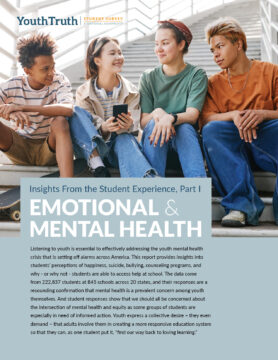Research Report
Insights From the Student Experience, Part I: Emotional & Mental Health
Overview
Listening to youth is essential to effectively addressing the youth mental health crisis that is setting off alarms across America. This report provides insights into students’ perceptions of happiness, suicide, bullying, counseling programs, and why – or why not – students are able to access help at school.

The data come from 222,837 students at 845 schools across 20 states, and their responses are a resounding confirmation that mental health is a prevalent concern among youth themselves. And student responses show that we should all be concerned about the intersection of mental health and equity as some groups of students are especially in need of informed action. Youth express a collective desire – they even demand – that adults involve them in creating a more responsive education system so that they can, as one student put it, “find our way back to loving learning.”
-

SECTION 1: OBSTACLES TO LEARNING
“Depression, stress, and anxiety” is the most prevalent obstacle to learning for secondary students at every grade level, six through twelve. The overall percentage of secondary students who identify “getting picked on or bullied” as an obstacle to learning drops from grades six through twelve; however, LGBTQ+ middle and high school students report at double the percentage of their peers that bullying is an impediment to learning.
-

SECTION 2: THE HAPPINESS GAP
The percentage of children and youth who feel happy about their lives declines from grades three through twelve. At every grade level there is a gender happiness gap as a larger percentage of boys report feeling happy about their lives than their classmates who identify as female or non-binary.
-

SECTION 3: GETTING HELP
Just over one in five middle and high school students report that they have accessed a school counselor, a therapist, or a psychologist when they are feeling upset, stressed, or having a problem. Fewer than half of middle school students and just over a third of high school students agree that their school has services or programs that help them when they are upset, stressed, or having problems.
-

SECTION 4: TALKING TO SOMEONE
The percentage of elementary students who report that they have an adult they can talk to at school when they are upset drops steadily from third grade (61 percent) to fourth grade (55 percent) to fifth grade (50 percent). Fewer than half of secondary students, regardless of grade level, gender, race, or LGBTQ+ status, report that they have an adult at school they can talk to when they feel upset, stressed, or have a problem.
-

SECTION 5: SUICIDE
Overall 13 percent of middle school students and 14 percent of high school students report that they have considered suicide in the last year. There is no significant difference in the percentage of youth reporting that they have considered suicide in the previous year by grade level or by race; however, there are alarming differences by gender identity and LGBTQ+ status.